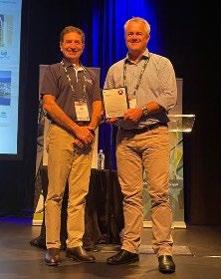TRAFFIC MANAGEMENT
POST-COVID PEAK HOUR TRAFFIC DEMAND MANAGEMENT - CAN WE DO BETTER?
Gleb Kolenbet, Principal Integrated Transport Engineer, Moreton Bay Regional Council This paper was delivered at IPWEAQ’s SEQ Branch conference in February.
Commuting by car is more popular than public transport (PT) in South East Queensland (SEQ). Car commuting is less efficient than PT: it significantly increases congestion during peak times and comes at various costs, including economic, health, social and environmental. While the apparent answer to fixing congestion is to upgrade road infrastructure, more roads create an ‘induced demand’ and promote more congestion. Recent events associated with the COVID-19 pandemic management in SEQ saw unprecedented measures such as restrictions on people’s movement and complete lockdowns. During the peak of restrictions in April 2020,
peak hour congestion and patronage on PT dropped significantly, while active travel participation (mainly cycling) increased. At around the same time, the Australian Government announced that the country entered a recession and began prompting the economy by introducing stimulus programs and fast-tracking infrastructure spending. A record $110 billion land transport infrastructure program was announced, spanning over the next 10 years. Local Roads and Community Infrastructure programs had a 200% ($1 billion) fund injection, totalling a $1.5 billion commitment year on year. By August 2020, many restrictions were lifted as SEQ entered a recovery mode. Most of the workforce that worked from home during the height of the pandemic began returning to workplaces and the traffic congestion worsened. February 2021 recorded higher congestion levels compared with the same period of 2020 and 2019. The recent traffic congestion data is concerning as it draws commuters to driving instead of using PT. ‘Fixing’ congestion isn’t
simple. It requires a holistic approach towards improved commuter demand management in the future. Transport planning professionals and policymakers should explore initiatives including working from home (WFH), flexible start times and double shifts for schools, and increasing investment into PT and active travel networks to manage travel demand better and encourage modal shift away from a private vehicle. Despite the transport infrastructure investment efforts by all government levels, the private vehicle remains by far the most popular mode of commuting to work in greater Brisbane and SEQ (Figure 1) (.idcommunity, 2020). According to transport planners, private vehicles are the least favourable option because every private car occupant produces an average of 11 times the congestion compared to a bus passenger (Thomson and Bull, 2006). The reliance on cars over public transport (PT) for daily commuting stems from post-war planning that re-directed many cities’ future by favouring cars (Woodcock, 2019). The population of SEQ has grown increasingly and many suburban growth corridors are spread across vast areas, making the daily commute longer, especially during am and pm peaks. PT remains a less popular choice because private
ENGINEERING FOR PUBLIC WORKS | MARCH 2021
71



























